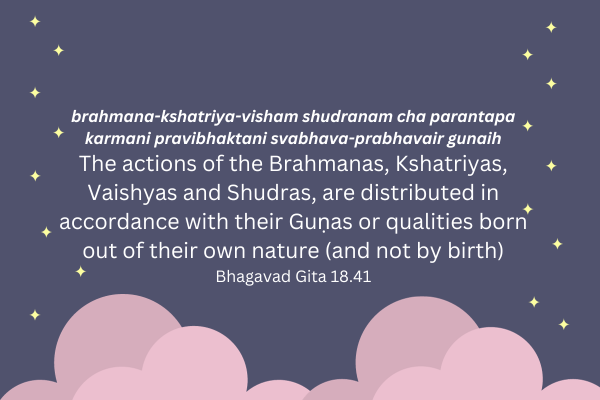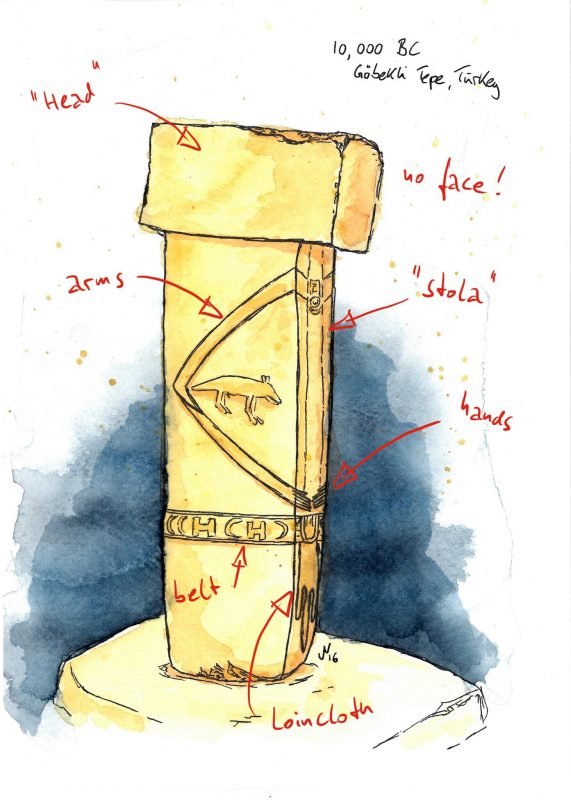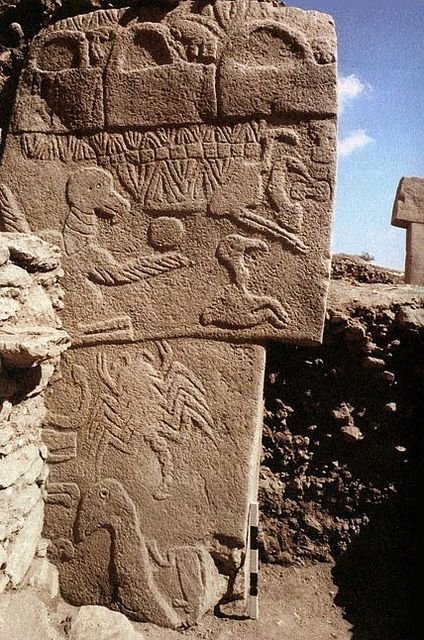Verses 10.90.8, 9 & 10:
This is the Final Part of my blog on Purusha Suktam wherein Verses 10.90.8 to 10.90.16 are discussed. Please note all the 16 verses which are discussed in my three blogs on the subject are taken from Rig Veda, composed by Narayana Rishi.
तस्मा॑द्य॒ज्ञात्स॑र्व॒हुत॒: सम्भृ॑तं पृषदा॒ज्यम् । प॒शून्ताँश्च॑क्रे वाय॒व्या॑नार॒ण्यान्ग्रा॒म्याश्च॒ ये ॥ Verse 8
tasmād yajñāt sarvahutaḥ sambhṛtam pṛṣadājyam|paśūn tām̐ś cakre vāyavyān āraṇyān grāmyāś ca ye ||
तस्मा॑द्य॒ज्ञात्स॑र्व॒हुत॒ ऋच॒: सामा॑नि जज्ञिरे । छन्दां॑सि जज्ञिरे॒ तस्मा॒द्यजु॒स्तस्मा॑दजायत ॥ Verse 9
tasmād yajñāt sarvahuta ṛcaḥ sāmāni jajñire | chandāṃsi jajñire tasmād yajus tasmād ajāyata ||
तस्मा॒दश्वा॑ अजायन्त॒ ये के चो॑भ॒याद॑तः । गावो॑ ह जज्ञिरे॒ तस्मा॒त्तस्मा॑ज्जा॒ता अ॑जा॒वय॑: ॥ Verse 10
tasmād aśvā ajāyanta ye ke cobhayādataḥ | gāvo ha jajñire tasmāt tasmāj jātā ajāvayaḥ ||
Translations:
Verse 8: From this Yajna, where the entire offering is complete (sarvahuta), with the contribution of both Prakriti & Purusha together, the curd with ghee mixture or sacred ghrta (pṛṣadājyam) was obtained. Then the beings who live in the air (vāyavyān), forest (āraṇyān) & land or village (grāmyāś) came forth
Comments on Verse 8: In this Yagna, Purusha who is the one Cosmic Soul of all beings is offered in the mind of the Rishis so that the process of creation of matter & energy, space & time continues in this Universe. The formation of the sacred ghrta or ghee (conversion of curd into butter and then further into ghee), translated as a mixture of curds & ghee (pṛṣadājyam) is also mentioned in the Big Bang theory as hot ionized plasma as given in my previous post (<click here).
Verse 9: From this Yagna, after everything was consumed, were born Rig & Samans. From Him arose Chhandas the poetic meters and were born the Yajus
Comments on Verse 9: For a brief understanding of Vedas, please click here to refer my two blogs on “Synopsis on Vedas” & “Understanding Vedas”
Verse 10: From that Yajna were born horses (aśvā), also those that have two row of teeth both up and down (ubhayādataḥ). From that were born the cows (gāvo), goats (ajā) & sheep (avayah)
Verses 10.90.11 & 12:
यत्पुरु॑षं॒ व्यद॑धुः कति॒धा व्य॑कल्पयन् । मुखं॒ किम॑स्य॒ कौ बा॒हू का ऊ॒रू पादा॑ उच्येते ॥ Verse 11
yat puruṣaṃ vyadadhuḥ katidhā vy akalpayan | mukhaṃ kim asya kau bāhū kā ūrū pādā ucyete ||
ब्रा॒ह्म॒णो॑ऽस्य॒ मुख॑मासीद्बा॒हू रा॑ज॒न्य॑: कृ॒तः । ऊ॒रू तद॑स्य॒ यद्वैश्य॑: प॒द्भ्यां शू॒द्रो अ॑जायत ॥ Verse 12
brāhmaṇo ‘sya mukham āsīd bāhū rājanyaḥ kṛtaḥ | ūrū tad asya yad vaiśyaḥ padbhyāṃ śūdro ajāyata ||
Translations:
Verse 11: In how many ways (katidhā) did they divide (vyadadhuḥ) the Purusha? (In other words, how many ways did the Rishis visualize the various manifestations of Purusha)? What was the mouth-mukhaṃ? Arms- bāhū? Thighs- ūrū? And feet-pādā? What are they called now?
Verse 12: Brahmana, who is a symbol of divinity is the mouth of Purusha. Kshatriya, who is the protector of dharma & society, is the Arms. Vaishya, who is the protector of wealth & resources is His thighs. Shudra, who is the secondary support system of all the above and involved only in labor, is His legs or feet – Verse 12
Comments:
Verse 12 has often been misinterpreted as being very derogatory to certain castes. It is clear from this Verse – Whether it is Brahmana, Kshatriya, Vasiya or a Shudra, all of them are a part of the Supreme Purusha (Brahman ). Also, they all have manifested from Purusha himself! So the question of discrimination does not arise. This Verse talks about Varna system that existed, which subsequently came to known as caste after the foreign invasions of Bharat! Our ancient ancestors made these categories based on each person’s Gunas (mental temperament – Sattva, Rajas & Tamas < click here for one of my earlier blogs on this subject) and allocation of work was made accordingly. Based on this allocation of work, the Varnas (< click here for one of my earlier blogs on this subject) eventually evolved!
A MAN’S WORTH IS IN HIS MIND AND NOT IN HIS BODY! Mind has a Color according to “Guna”. As man evolves, Guna & Mind which are interrelated gets refined. The color of the man goes upward from Shudra to Brahmana, after passing through Vaishya & Kashtriya varnas.
Just as there are lower & higher classes in a school, the existence of all four Varnas in a society is natural. The plan of Nature (Prakriti) is that beings of low Varna evolve into a higher Varna. Our Gunas are constantly shifting, always changing in intensity. Though there is difference in the attainments of the four Varnas, there is no differentiation among their respective Dharma. The Dharma of the one is as sacred and conducive to enlightenment as that of the other. The mark of Dharma is Achara meaning “good conduct”.
In the Human body, the brain does the Brahmana dharma, the heart does the Kshatriya dharma, stomach does the Vaishya dharma & legs/feet does the Shudra Dharma. The Dharmas of all these faculties are of equal importance and a necessity. The same is the case with society too. A quote from Bhagavad Gita 18.41 given below, explains how action of various Varnas depend on their individual Gunas.
Verses 10.90.13 &14:
च॒न्द्रमा॒ मन॑सो जा॒तश्चक्षो॒: सूर्यो॑ अजायत । मुखा॒दिन्द्र॑श्चा॒ग्निश्च॑ प्रा॒णाद्वा॒युर॑जायत ॥ Verse 13
candramā manaso jātaś cakṣoḥ sūryo ajāyata | mukhād indraś cāgniś ca prāṇād vāyur ajāyata ||
नाभ्या॑ आसीद॒न्तरि॑क्षं शी॒र्ष्णो द्यौः सम॑वर्तत । प॒द्भ्यां भूमि॒र्दिश॒: श्रोत्रा॒त्तथा॑ लो॒काँ अ॑कल्पयन् ॥ Verse 14
nābhyā āsīd antarikṣaṃ śīrṣṇo dyauḥ sam avartata | padbhyām bhūmir diśaḥ śrotrāt tathā lokām̐ akalpayan ||
Translations:
Verse 13: The moon was born from the mind, sun was born from the eye, then Indra (Lord of all Gods) & Agni or fire came from the mouth and vayu or air/wind from the prāna or breath
Verse 14: The sky was born from the navel of Purusha, heavens arose from the head, from the feet came the earth, the four directions or space from the ear and thus all other realms or regions were created from Purusha
Comments: The above verses indicate how both the macrocosm (Cosmos) & microcosm (Humans) are inter-connected. The outward universe is the same as the universe within us. Purusha is the all-pervasive entity who brings about this oneness. Two examples from Upanishads are given below:
Chāndogya Upanishad 1.6 & 1.7: Purusha of whom the Upanishads say “who is residing in the Sun and who is residing in the eye, is God Himself.
Bṛhad-āranyaka Upanishad: 1.5.22: Fire said “I will go on burning”, Sun said “I will go on warming”, Moon said “ I will go on shining” and all other Gods said they will follow their individual divine function. Prana is the “vital force” in our body, so is Vayu (Air) among the gods or divinities and Vayu or Air is that divinity that never rests”
Verse 10.90.15:
स॒प्तास्या॑सन्परि॒धय॒स्त्रिः स॒प्त स॒मिध॑: कृ॒ताः । दे॒वा यद्य॒ज्ञं त॑न्वा॒ना अब॑ध्न॒न्पुरु॑षं प॒शुम् ॥ Verse 15
saptāsyāsan paridhayas triḥ sapta samidhaḥ kṛtāḥ | devā yad yajñaṃ tanvānā abadhnan puruṣam paśum ||
Translation:
Seven became the borders (paridhaya) of the Cosmic Vedi or Altar, thrice seven (21– triḥ sapta) are the fire wood sticks (samidah), when the Celestials (Devas) confined or bound Purusha, who is the sacrificial offering (paśum), in their mind to enact the Yagna in order to realize the cosmic process of evolution. (Then from the un-manifested Purusha sprung forth the manifested Universe).
Comments: In Sanskrit grammar words denoting direction, quarter and number are combined with nouns to form various terminologies; for example Dakṣiṇāgni (meaning south-fire, as south is the direction of our ancestors) & Saptarishis (seven (sapta) well-known sages or rishis and the seven stars of the Big Dipper or Ursa Major constellation).
We will now look at the various ways each of these three key words have been translated by Vedic scholars & others: 1) saptā (7) 2) triḥ sapta (21) 3) paśum
1) saptā (seven):
- The seven boundaries are the seven chhandas or poetic meters of Veda mantras such as Gayatri, Ushnik, Anushtup, Brihati, Pangkti, Trishtup & Jagati.
- In the “Agnicayana” ritual, the patron or yajamana will have three altars: one circular (earth), half-moon (atmosphere), and the last square (sky), which symbolizes the head, heart, and body of the Cosmic Man (Purusa). During the Agnicayana ritual, the two altars representing the sky and the atmosphere will be built to the east end of the ceremony. After the five layers a wooden mortar is placed on top (this is the sixth layer is the heavenly world), and on top of the mortar theukha (pot or vessel is prepared from clay) will be placed (which represents a ‘seventh layer, immortality’). Thus the integration of the cosmos with the construction of the fire altars are very precisely practiced and honored during the Agnicayana ritual. These then are these seven layers used in this ritual.(Purusha Suktam< click here for a write up on Agnicayana ritual by author Subhash Kak)
- In Brahma Sutras, seven modifications are – Mahat (intellect), Ego and Five subtle elements (space, air, fire, water, earth). They are both modifications and sources! Mahat evolves from Prakriti and then evolves into egoism. The subtle elements evolve from Ego and further evolve into gross elements.
2) triḥ sapta :
Twenty one samidah or fire sticks are: Prakriti (Material Cause of the Universe), Mahat (the Cosmic principle), Ahankara (the cosmic plan of the Universe), Five objects of perception or Tanmatras (Sound, Sight, Smell, Taste & Touch), Five elements (Pancah Bhutas – space, air, fire, water, earth), Five sense organs (Jnanendriyas – Ears, Eyes, Nose, Mouth/Tongue & Skin) & three Gunas or qualities: Sattva (Harmony or Rhythm), Rajas (Activity or Mobility) & Tamas (Inertia or Matter) making it a total of 21
3) paśum:
- Some have interpreted Paśum as animal (which also is one of the meanings), who is confined or bound in this sacrifice. The word Pashu comes from the root word “Pash” which means to “one who sees, looks or observes”. Therefore the meaning is “Purusha – the Cosmic Observer” who is meditated upon in this verse. In Vedanta, Brahman or Supreme Consciousness is also known as “Witness or Observer” as stated in my blog on this subject.
- Paśum also means an “offering” and in this case Purusha is the symbolic sacrificial offering.
Purusha sacrifice depicted on a pillar in Göbekli Tepe, Turkey:
Göbekli Tepe is an archaeological site dating back to 10,000 years and it is claimed to be the oldest man made structure found so far. The site consists of several large circular enclosures, made of massive limestone pillars arranged in rings. These pillars, some of which reach up to 6 meters in height and weighs several tons, are intricately carved with elaborate reliefs of animals, abstract symbols, and human figures. The level of craftsmanship displayed in these carvings suggests a highly developed, perceptive and symbolic culture. Göbekli Tepe appears to be a ceremonial, religious or ritual site, rather than an area consisting of human settlements, as no evidence otherwise has been found.
I give below my own interpretation of Purusha sacrifice in the sketch given below: These photos show the faceless image of a larger than life or an imposing human being with arms & hands, wearing a loin cloth, bound by a belt, carved on a huge T- pillar, indicating a symbolic sacrifice ritual. This tall T-pillar is known as Yūpa (यूप), or Yūpastambha, a “Vedic sacrificial post or pillar” (Stambha meaning pillar is sometimes also called “Skambha”. It is built tall because it symbolically connects heaven & earth). Loin cloth is worn by “Sadhus or Nagas” of India. It signifies a man who has given up all material possessions and living a simple & meagre life. Another image below shows three water pots also known as “Kamandalu or Kamandalam or Kamandala”. The sacred water stored in the Kamandalu is either used for sanctifying or purification. Water has the power to carry one’s conscious intentions. Kamandalu is therefore viewed as a symbol of an Ascetic or Holy Man in Hinduism.
Click here for Image Credit & Source
The actual photograph of Pillar 31 in Building D showing anthropomorphic features like hands and arms and pieces of clothing is also shown on this website.
Verse 10.90.16:
य॒ज्ञेन॑ य॒ज्ञम॑यजन्त दे॒वास्तानि॒ धर्मा॑णि प्रथ॒मान्या॑सन् । ते ह॒ नाकं॑ महि॒मान॑: सचन्त॒ यत्र॒ पूर्वे॑ सा॒ध्याः सन्ति॑ दे॒वाः ॥16
yajñena yajñam ayajanta devās tāni dharmāṇi prathamāny āsan | te ha nākam mahimānaḥ sacanta yatra pūrve sādhyāḥ santi devāḥ ||
Translation:
By that Yajna, the sages realize the cosmic process of evolution by fixing their mind on Purusha, who is the master of that Cosmic Yajna and further realized the original Dharma (right path of conduct). Blessed by the divine, they achieved the same glory that the Celestials (devās) & accomplished men (Sādhyāḥ) had obtained before, at the beginning of creation.
Comments: Creation is symbolized as a Yagna and the sages mimic the same Yajna with the desire to merge with the original & efficient cause – Purusha, just like devas (Gods) & sādhyāḥs (scholars who guide the process of manifestation) did during the ancient times.
Conclusion & Summary:
Purusha Suktam begins with the first 5 verses describing the glory of Purusha, the Cosmic Being and the potential that exists within him to manifest into various forms. With the introduction of Virat Purusha, He then starts the process of manifestation with Purusha himself remaining as the substratum in the background. The next 5 verses explains the Great Yagna or fire sacrifice where the hot ionized plasma or ghrta was obtained and the emergence of various animate & inanimate beings. The next 5 verses then elaborate further on the various forms that came out of each of his body parts. Finally, the sages performing the Yajna, then experience the same divinity that the primordial sages were blessed with, at the beginning of creation.
Purusha is the infinite, eternal, cosmic and transcendent Being. He is the Absolute Reality, the un-manifested Supreme Brahman! Purusha is both microcosmic and macrocosmic. The Yajna is beautifully used as a metaphor to describe the creation. The meditation on this Cosmic Being leads one to merge with the Supreme Self.
References:
- The Principal Upanishadsby Dr. S. Radhakrishnan (Translation of Upanishads taken from this book)
- Rig Veda by Dr. Tulsi Ram (English Translations of Rig Veda)
- Few snippets from The Bhagavad Gita by Swami Chidbhavananda


